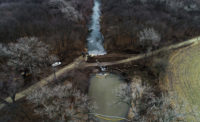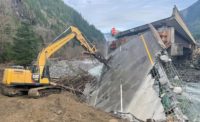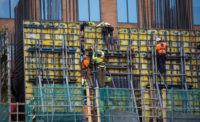Canada Won’t Release Report on 2021 Crane Collapse That Killed Five

Long-awaited report on what caused a 2021 Kelowna, B.C. tower crane failure that killed five was not issued publicly.
Photo by Alistair Waters/The Canadian Press via AP
Nearly two years after one of the deadliest crane collapses in North America, regulators in British Columbia have finished a probe into what went wrong with the dismantling of a tower crane on a 25-story construction project on July 12, 2021, to cause the deaths of four site workers and an engineer in an adjacent building.
But provincial regulator WorkSafeBC won’t publicly release the report on the horrific accident as was planned, citing an “extensive and complex” criminal probe by the Royal Canadian Mounted Police (RCMP).
Police are examining “thousands of pieces of evidence and seized documentation, and consulting with our partners nationally,” according to a joint statement by WorkSafeBC and RCMP. “It is anticipated that this investigation will remain ongoing for an extended period,” the agencies stated, declining to say who is targeted for potential criminal charges or how the release of details about the accident would jeopardize the probe.
The collapse occurred during the dismantling operation at a condo high-rise site in Kelowna, a town 240 miles east of Vancouver. The building, part of a multi-structure complex planned by local developer Mission Group, had been 70% sold several months before construction began in 2019.
WorkSafeBC said it worked with nearly two dozen experts and engineers in its investigation, examining “crane components, sequence of events and work procedures that took place during the crane dismantling process,” as well as analyzing documents and conducting interviews. The names, companies and scopes of work of those supporting the probe were not disclosed.
The collapse has led to new and intensified crane-related safety initiatives in British Columbia, according to information released by provincial officials. Regulations took effect on March 1 requiring cranes to be equipped with a zone-limiting device to prevent collision if they are “working in proximity to high voltage electrical equipment” or near other tower cranes.
Starting on Jan. 1, 2024, a pump operator certificate will be needed to run either a concrete pump or a placing boom at a construction site, according to WorkSafeBC.
In addition, the safety regulator said it has launched a crane and mobile equipment inspection initiative that targets “industries and employers with a high risk of serious workplace injury and a significant contribution to the serious injury rate and the time-loss claims rate.” Among its objectives are tackling “catastrophic risks” related to “assembly, disassembly, or repositioning of tower cranes.”
WorkSafeBC has also deployed a seven-member provincial crane inspection team, which conducted more than 930 inspections last year, issuing 25 stop-work orders, the agency said. It also has launched a “Level Up Inspection Program,” with five guides detailing safe practices during each stage of crane use, placement, assembly and disassembly.
The 2021 collapse killed brothers Eric Stemmer, site superintendent, and Patrick Stemmer, a project crane operator, for family-owned Stemmer Construction Ltd., based in B.C., as well as firm employees Jared Zook and Cailen Vilness.
The body of Brad Zawislak, described on a LinkedIn page as a civil engineering technologist employed by Protech Consulting 2012 Ltd., was recovered under the rubble of a building in which he was working when crane debris crashed through its roof. The deaths were revealed in GoFundMe posts.
Stemmer had initially opposed police keeping three company laptop computers containing project data longer than the one-year period allowed under provincial law. But a B.C. court ruled in August that the RCMP could retain the computers and data until July 12, 2023, according to a Canadian news report.





